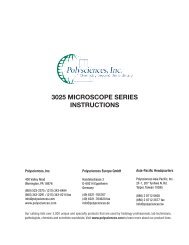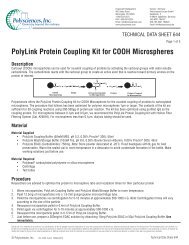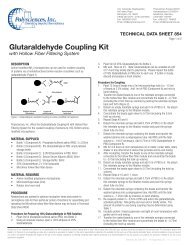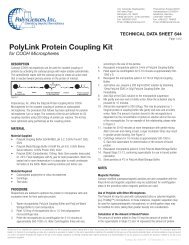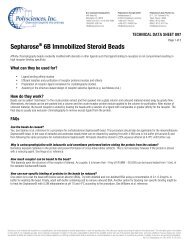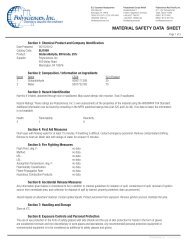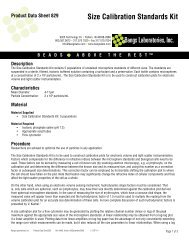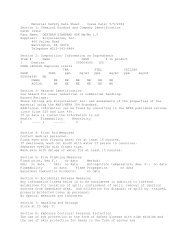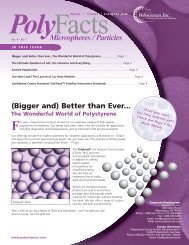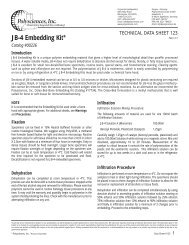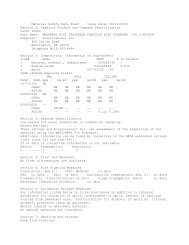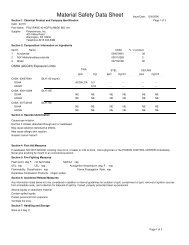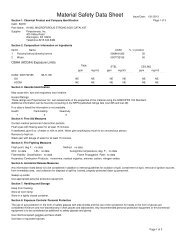Data Sheet #615: Protein Conjugated ... - Polysciences, Inc.
Data Sheet #615: Protein Conjugated ... - Polysciences, Inc.
Data Sheet #615: Protein Conjugated ... - Polysciences, Inc.
Create successful ePaper yourself
Turn your PDF publications into a flip-book with our unique Google optimized e-Paper software.
U.S. Corporate Headquarters<br />
400 Valley Rd.<br />
Warrington, PA 18976<br />
1(800) 523-2575 / (215) 343-6484<br />
1(800)343-3291 fax<br />
info@polysciences.com<br />
<strong>Polysciences</strong> Europe GmbH<br />
Handelsstrasse 3<br />
D-69214 Eppelheim, Germany<br />
+(49) 6221-765767<br />
+(49) 6221-764620 fax<br />
info@polysciences.de<br />
<strong>Polysciences</strong> Asia-Pacific, <strong>Inc</strong>.<br />
2F-1, 207 Tunhwa N. Rd.<br />
Taipei, Taiwan 10595<br />
(886) 2 8712 0600<br />
(886) 2 8712 2677 fax<br />
info@polysciences.tw<br />
<strong>Protein</strong> <strong>Conjugated</strong> Microspheres<br />
TECHNICAL DATA SHEET 615<br />
Page 1 of 2<br />
INTRODUCTION<br />
<strong>Polysciences</strong>, <strong>Inc</strong>. offers antibodies, <strong>Protein</strong> A, and <strong>Protein</strong> G covalently<br />
coupled to dyed (fluorescent and non-fluorescent) and undyed<br />
microspheres. Antibody conjugated microspheres are used to detect trace<br />
amounts of antigens in solution via bead-based ELISA and agglutination<br />
tests. Microspheres conjugated with <strong>Protein</strong> A and <strong>Protein</strong> G can be used<br />
to purify IgG by binding to the Fc portion of antibodies raised in most<br />
mammals.<br />
Our protein conjugated microspheres have a diameter of 1.0µm and are<br />
offered as aqueous suspensions containing microspheres at a concentration<br />
of approximately 1.25%. They are packaged in a 0.02M sodium phosphate<br />
buffer, pH 7.4, containing 8mg/ml NaCl, 10mg/ml bovine serum albumin,<br />
0.1% sodium azide, and 5% glycerol. Each lot of the protein conjugated<br />
microspheres is quality control tested for mean particle diameter, % solids,<br />
and the concentration of protein conjugated to the microspheres. This<br />
information is reported on the product label. The fluorescent yellow-green<br />
(YG) microspheres have an excitation maximum of 445nm and an emission<br />
maximum of 500nm, similar to FITC. For best results, these microspheres<br />
should be stored at 4˚C, not frozen, and mixed before using.<br />
PROCEDURE<br />
These protocols are offered as guides. Specific situations may require one or<br />
more alterations to these protocols. Researchers are advised to optimize the<br />
use of particles in any application.<br />
Antibody <strong>Conjugated</strong> Microspheres<br />
Goat anti-Mouse IgG (H&L) and Goat anti-Rabbit IgG (H&L) are available<br />
on 1.0µm polystyrene microspheres. These antibodies are available on<br />
plain, visible blue dyed, or fluorescent yellow-green (YG) microspheres. The<br />
antibody concentration is 250-350µg/ml depending on the lot.<br />
Protocol for Use with Antibody <strong>Conjugated</strong> Microspheres<br />
1. In order to remove the sodium azide and transfer to the appropriate<br />
buffer, the microspheres must be washed before use. To do this,<br />
aliquot 0.5ml of 1.25% Antibody <strong>Conjugated</strong> Microspheres into an<br />
Eppendorf centrifuge tube (1.5-1.9ml capacity). Add sufficient amount<br />
of buffer or cell culture media to fill the tube. Note: Use buffer or culture<br />
media that is compatible with the current application. Centrifuge in<br />
a micro-centrifuge at 10,000 x G for 5-6 minutes. Carefully remove<br />
the supernatant using a Pasteur pipette. Discard supernatant and<br />
resuspend microspheres in fresh buffer. Repeat this procedure three<br />
times in order to sufficiently wash the microspheres.<br />
2. <strong>Inc</strong>ubate the microspheres with an appropriate amount of the target<br />
antigen for a minimum of 20-30 minutes at 4˚C. This can also be<br />
performed at room temperature, if necessary. The amount of target<br />
antigen can vary widely. The researcher is strongly encouraged to<br />
optimize the antibody/microsphere ratio prior to using the microspheres<br />
in their applications. Antigen amounts may range from 10-300µg.<br />
3. To remove any excess antigen that is not attached to the microspheres,<br />
wash the microspheres one time using the centrifugation procedure<br />
outlined in Step 1. The microsphere-antigen complex is now ready for<br />
analysis or experimentation.<br />
<strong>Protein</strong> A and <strong>Protein</strong> G <strong>Conjugated</strong> Microspheres<br />
<strong>Protein</strong> A and <strong>Protein</strong> G are available on 1.0µm polystyrene microspheres.<br />
These proteins are available on plain, visible blue dyed, or fluorescent<br />
yellow-green (YG) microspheres. The protein concentration is 150-250µg/ml<br />
depending on the lot.<br />
Protocol for Use with <strong>Protein</strong> A and <strong>Protein</strong> G <strong>Conjugated</strong><br />
Microspheres<br />
<strong>Protein</strong> A/G Buffer: 0.1M Tris-HCl, 0.15M NaCl<br />
1. Add 100µl of <strong>Protein</strong> A or <strong>Protein</strong> G microspheres to a 1.5ml<br />
microcentrifuge tube.<br />
2. Wash microspheres three times with 750µl of <strong>Protein</strong> A/G Buffer by<br />
mixing the buffer, centrifuging in a micro-centrifuge for 5-6 minutes at<br />
10,000 x G, and then removing the supernatant.<br />
3. To the washed microspheres, add 50µl of serum containing the target<br />
IgG and 50µl of <strong>Protein</strong> A/G Buffer. <strong>Inc</strong>ubate for 1 hour at 4˚C, vortexing<br />
every five minutes.<br />
4. Centrifuge microspheres 5-6 minutes at 10,000 x G in a<br />
microcentrifuge. Remove the supernatant and discard.<br />
5. Wash with 750µl of <strong>Protein</strong> A/G Buffer three times.<br />
6. To elute the bound antibody, add 50µl of 0.1M glycine, pH 2.5, vortex,<br />
and incubate for five minutes. Centrifuge to separate the microspheres<br />
and save supernatant, which contains the purified IgG.<br />
STORAGE AND SAFETY<br />
Storage Store at 4-8˚C. Freezing of particles may result in irreversible<br />
aggregation and loss of binding activity.<br />
Safety<br />
This particle suspension contains sodium azide. Sodium azide<br />
may react with lead and copper plumbing to form explosive metal<br />
azides. Upon disposal of material, flush with a large volume of<br />
water to prevent azide accumulation. Please consult the Material<br />
Safety <strong>Data</strong> <strong>Sheet</strong> for more information.<br />
Should any of our materials fail to perform to our specifications, we will be pleased to provide replacements or return the purchase price. We solicit your inquiries concerning all needs for life sciences work. The information given in this<br />
bulletin is to the best of our knowledge accurate, but no warranty is expressed or implied. It is the user’s responsibility to determine the suitability for their own use of the products described herein, and since conditions of use are beyond<br />
our control, we disclaim all liability with respect to the use of any material supplied by us. Nothing contained herein shall be construed as a recommendation to use any product or to practice any process in violation of any law or any<br />
government regulation.<br />
Technical <strong>Data</strong> <strong>Sheet</strong> 615 © <strong>Polysciences</strong>, <strong>Inc</strong>. - REV: NOV/05/2012
TECHNICAL DATA SHEET 615<br />
Page 2 of 2<br />
These products are for research use only and are not intended for<br />
use in humans or for in vitro diagnostic use.<br />
ORDERING INFORMATION<br />
Cat. # Description Size<br />
Goat anti-Mouse IgG (H&L) <strong>Protein</strong> A<br />
17697 Blue Dyed Polystyrene Microspheres 1ml<br />
17699 Blue Dyed Polystyrene Microspheres 1ml<br />
17694 Undyed Microspheres 1ml<br />
17698 Undyed Microspheres 1ml<br />
17843 Fluoresbrite ® YG Polystyrene Microspheres 1ml<br />
17845 Fluoresbrite ® YG Polystyrene Microspheres 1ml<br />
Goat anti-Rabbit IgG (H&L) <strong>Protein</strong> G<br />
17696 Blue Dyed Polystyrene Microspheres 1ml<br />
21105 Blue Dyed Polystyrene Microspheres 1ml<br />
17693 Undyed Microspheres 1ml<br />
21106 Undyed Microspheres 1ml<br />
17844 Fluoresbrite ® YG Polystyrene Microspheres 1ml<br />
21107 Fluoresbrite ® YG Polystyrene Microspheres 1ml<br />
TO ORDER<br />
In The U.S. Call: 1(800) 523-2575 • (215) 343-6484<br />
In The U.S. Fax: 1(800) 343-3291 • (215) 343-0214<br />
In Germany Call: +(49) 6221-765767<br />
In Germany Fax: +(49) 6221-764620<br />
In Asia Call: (886) 2 8712 0600<br />
In Asia Fax: (886) 2 8712 2677<br />
Order online anytime at www.polysciences.com<br />
Should any of our materials fail to perform to our specifications, we will be pleased to provide replacements or return the purchase price. We solicit your inquiries concerning all needs for life sciences work. The information given in this<br />
bulletin is to the best of our knowledge accurate, but no warranty is expressed or implied. It is the user’s responsibility to determine the suitability for their own use of the products described herein, and since conditions of use are beyond<br />
our control, we disclaim all liability with respect to the use of any material supplied by us. Nothing contained herein shall be construed as a recommendation to use any product or to practice any process in violation of any law or any<br />
government regulation.<br />
Technical <strong>Data</strong> <strong>Sheet</strong> 615 © <strong>Polysciences</strong>, <strong>Inc</strong>. - REV: NOV/05/2012



